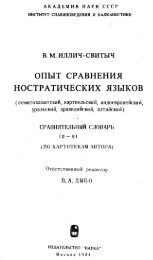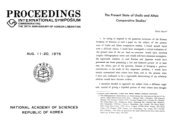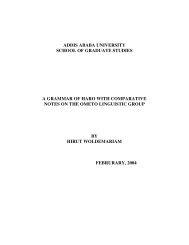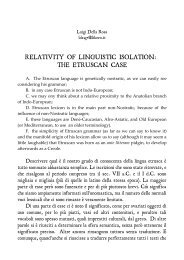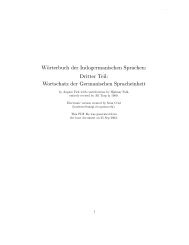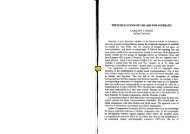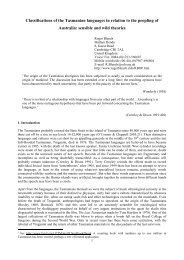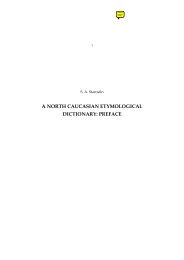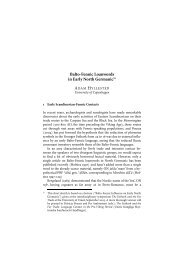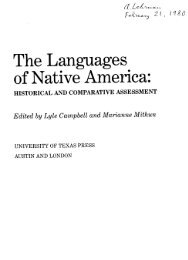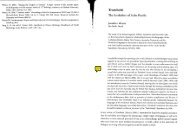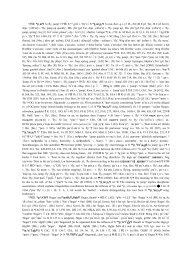The Indo-European Elements in Hurrian
The Indo-European Elements in Hurrian
The Indo-European Elements in Hurrian
Create successful ePaper yourself
Turn your PDF publications into a flip-book with our unique Google optimized e-Paper software.
6. Verbal Morphology 63<br />
- < 9. šu-ul-lu-ú-ub-ri e-er-bi-né-eš e-ep-¯e-e-ni ><br />
- < 10. ta-la-a¯-¯u-u-um * ta-la-a¯-¯u-u-um e-ep-¯e-e-ni ><br />
- < 11. ¯a-a-šar-ri pu-ú-si-¯u-um * pu-ú-si-¯u-um ><br />
- < 12. ¯a-a-šar-ri na-a¯-¯a-ab ú-la-nu-u-um ><br />
‘9. A šullûubri (bread) the dog <strong>in</strong> the oven, 10. draw<strong>in</strong>g * draw<strong>in</strong>g <strong>in</strong> the oven, 11. <strong>in</strong> the<br />
oil dipp<strong>in</strong>g * dipp<strong>in</strong>g, 12. <strong>in</strong> the oil lied down hav<strong>in</strong>g a meal.’<br />
<strong>The</strong>re is only one subject: erbi-ni-š ‘the dog (Erg.)’ and one f<strong>in</strong>ite verbal form: na¯¯ab<br />
‘he lied down’. <strong>The</strong> other verbal forms with -m end<strong>in</strong>g are participles. It can also be noted that<br />
several words <strong>in</strong> the Absolutive case are used with an unmarked Locative mean<strong>in</strong>g. And this<br />
section is also written <strong>in</strong> dactylic hexameters as the previous one.<br />
Accord<strong>in</strong>g to Wilhelm (2004a:111) and Bush (1964:187—193), <strong>Hurrian</strong> dist<strong>in</strong>guished<br />
tense differences by means of the follow<strong>in</strong>g suffixes:<br />
a) Present tense: -Ø;<br />
b) Past tense: -oš- *[-os-] <strong>in</strong> Wilhelm's recontruction of <strong>Hurrian</strong>;<br />
c) Future: -ett- *[-et-] <strong>in</strong> Wilhelm's recontruction of <strong>Hurrian</strong>.<br />
(Accord<strong>in</strong>g to Diakonoff—Starost<strong>in</strong> [1986:89—90], there is some <strong>in</strong>dication that these suffixes<br />
may have once been aspect markers.)<br />
This approach does not seem to be correct on several counts. It seems that the past tense<br />
maker is only -š- *[s] without the vowel. What Wilhelm reconstructs as a vowel *o is noth<strong>in</strong>g<br />
but the valency marker *-u-, someth<strong>in</strong>g that amply testifies to the untenability of this vowel<br />
system with *o and *e. <strong>The</strong> other valency marker -i- is shown <strong>in</strong> several person names, which<br />
Wilhelm (1996:176) considers obscure formations. We propose to <strong>in</strong>terpret them as follows:<br />
- Aniš-¯urbe ‘<strong>The</strong> rhyton made (him/her) happy’<br />
- Àaiš-Teššub ‘Teššub took (him/her)’ (cf. Àaib-Teššub)<br />
- Paiš-Kumme ‘Kumme built (it)’<br />
- Te¯iš-menni ‘Menni made (him/her) greater’<br />
- Šeriš-adal 89 ‘<strong>The</strong> strong (one) pleased (him, her)’<br />
<strong>The</strong> verb end<strong>in</strong>g -iš seems to be a more recent development than the obsolescent Old<br />
<strong>Hurrian</strong> end<strong>in</strong>g -ib.<br />
<strong>The</strong> tense marker of the future does not seem to be correct either. <strong>The</strong> marker is actually<br />
-ed- *[-(y)i:d]. <strong>The</strong> dental -tt- exists only as the marker of the third person plural. It can be<br />
noted that the future has grammatical aff<strong>in</strong>ities with the conditional, as shown by KBo 32.15 Ro<br />
I 8'—9', which connects:<br />
- <br />
- <br />
‘8'. Will Teššub be hungry, 9'. we would give half a kor of barley’<br />
89 This word is the orig<strong>in</strong> of the non-exist<strong>in</strong>g equative case marker -š <strong>in</strong> Speiser (1941:204).



